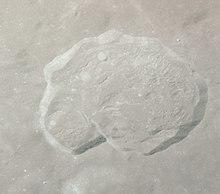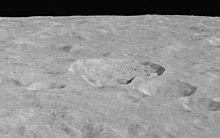 Lunar Orbiter 4 image | |
| Coordinates | 29°54′N 43°48′E / 29.9°N 43.8°E |
|---|---|
| Diameter | 39 km |
| Depth | 2.2 km |
| Colongitude | 317° at sunrise |
| Eponym | Simon Newcomb |

Newcomb is a lunar impact crater that is located in the rugged Montes Taurus mountain range, to the east of the Mare Serenitatis. It lies to the northeast of the prominent crater Römer, and north-northwest of Macrobius.
This crater has a sharp-edged and somewhat irregular rim that appears polygonal more than circular. There are terraces along the inner sides, with some slumping along the northern and western inner edge. The south-southwestern part of the rim is overlaid by the smaller crater Newcomb A. The interior floor is uneven, particularly near the rim of Newcomb A. Just to the south-southeast of the crater is the satellite crater Newcomb J. This feature is named after the American astronomer Simon Newcomb.[1]
Satellite craters
By convention these features are identified on lunar maps by placing the letter on the side of the crater midpoint that is closest to Newcomb.
| Newcomb | Latitude | Longitude | Diameter |
|---|---|---|---|
| A | 29.4° N | 43.5° E | 19 km |
| B | 28.4° N | 45.6° E | 23 km |
| C | 29.1° N | 45.3° E | 29 km |
| F | 31.4° N | 42.5° E | 28 km |
| G | 28.2° N | 44.6° E | 16 km |
| H | 28.9° N | 42.4° E | 12 km |
| J | 28.7° N | 44.3° E | 23 km |
| Q | 30.3° N | 42.8° E | 14 km |
See also
- Asteroid 855 Newcombia
- Newcomb (Martian crater)
References
- ^ "Newcomb (lunar crater)". Gazetteer of Planetary Nomenclature. USGS Astrogeology Research Program.
- Andersson, L. E.; Whitaker, E. A. (1982). NASA Catalogue of Lunar Nomenclature. NASA RP-1097.
- Bussey, B.; Spudis, P. (2004). The Clementine Atlas of the Moon. New York: Cambridge University Press. ISBN 978-0-521-81528-4.
- Cocks, Elijah E.; Cocks, Josiah C. (1995). Who's Who on the Moon: A Biographical Dictionary of Lunar Nomenclature. Tudor Publishers. ISBN 978-0-936389-27-1.
- McDowell, Jonathan (July 15, 2007). "Lunar Nomenclature". Jonathan's Space Report. Retrieved 2007-10-24.
- Menzel, D. H.; Minnaert, M.; Levin, B.; Dollfus, A.; Bell, B. (1971). "Report on Lunar Nomenclature by the Working Group of Commission 17 of the IAU". Space Science Reviews. 12 (2): 136–186. Bibcode:1971SSRv...12..136M. doi:10.1007/BF00171763.
- Moore, Patrick (2001). On the Moon. Sterling Publishing Co. ISBN 978-0-304-35469-6.
- Price, Fred W. (1988). The Moon Observer's Handbook. Cambridge University Press. ISBN 978-0-521-33500-3.
- Rükl, Antonín (1990). Atlas of the Moon. Kalmbach Books. ISBN 978-0-913135-17-4.
- Webb, Rev. T. W. (1962). Celestial Objects for Common Telescopes (6th revised ed.). Dover. ISBN 978-0-486-20917-3.
- Whitaker, Ewen A. (1999). Mapping and Naming the Moon. Cambridge University Press. ISBN 978-0-521-62248-6.
- Wlasuk, Peter T. (2000). Observing the Moon. Springer. ISBN 978-1-85233-193-1.
